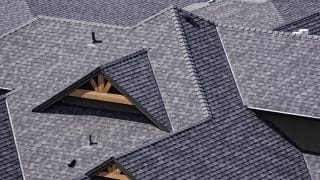What Is a Shear Wall and Why Do Buildings Need Them?
Jun 30, 2020

Being able to identify the various types of walls on a structural plan is an essential skill, but it’s also important to know what makes each type of wall unique. Professional builder Jordan Smith explains in his Introduction to Reading Blueprints course:
“When you’re reading a blueprint, you understand that all walls are not the same. You have shear walls, you have load-bearing walls, and you have architectural walls.”
What is a shear wall?
While columns and load-bearing walls keep buildings standing up, carrying the compression load of the structure down to its foundation, the shear wall is what keeps structures from blowing over, resisting the lateral forces of wind and seismic activity.
How do shear walls work?
Understanding all the physics of shear walls may require an education in structural engineering, but a simple way to grasp how they operate is to imagine a wooden square with four edges—essentially two columns and two beams. This frame can support weight from above—compression—as any load put on the upper beam is transferred through the columns to the base of the square.
But if you put too much pressure on its sides—a lateral force—and the square will twist and collapse on itself unless it is braced by supports. Shear walls have these braces and are designed so that they don’t collapse on themselves. In turn, they assure that no wind will blow your house down.
The support provided by shear walls does, however, create a design obstacle for architects. Whether the support against lateral forces is thanks to sheathing covering the frame or from other braces within it, any windows or doors must be limited in terms of the total area of the shear wall (and in some uses can’t be used at all).
What structures need shear walls?
Almost all houses have external shear walls, but internal shear walls are typically found only in larger houses and high-rise buildings subject to lateral winds and seismic forces. The taller the building, the greater the need for internal shear walls and a lateral force resisting system.
Placement of shear walls
As a general rule, the ideal placement for shear walls in high-rise buildings and those houses that require them is in the center of each half of a building. Beyond that, shear walls must be built symmetrically around the building’s central axis.
In other words, if there is a shear wall on its north side, it has to have an identical one on its south side. If there is a shear wall in the southeast corner of a building, then an identical shear wall will be placed on the opposite side of the central axis, in the southwest corner.
Being able to identify the various types of walls on a structural plan is an essential skill, but it’s also important to know what makes each type of wall unique. Professional builder Jordan Smith explains in his Introduction to Reading Blueprints course:
“When you’re reading a blueprint, you understand that all walls are not the same. You have shear walls, you have load-bearing walls, and you have architectural walls.”
What is a shear wall?
While columns and load-bearing walls keep buildings standing up, carrying the compression load of the structure down to its foundation, the shear wall is what keeps structures from blowing over, resisting the lateral forces of wind and seismic activity.
How do shear walls work?
Understanding all the physics of shear walls may require an education in structural engineering, but a simple way to grasp how they operate is to imagine a wooden square with four edges—essentially two columns and two beams. This frame can support weight from above—compression—as any load put on the upper beam is transferred through the columns to the base of the square.
But if you put too much pressure on its sides—a lateral force—and the square will twist and collapse on itself unless it is braced by supports. Shear walls have these braces and are designed so that they don’t collapse on themselves. In turn, they assure that no wind will blow your house down.
The support provided by shear walls does, however, create a design obstacle for architects. Whether the support against lateral forces is thanks to sheathing covering the frame or from other braces within it, any windows or doors must be limited in terms of the total area of the shear wall (and in some uses can’t be used at all).
What structures need shear walls?
Almost all houses have external shear walls, but internal shear walls are typically found only in larger houses and high-rise buildings subject to lateral winds and seismic forces. The taller the building, the greater the need for internal shear walls and a lateral force resisting system.
Placement of shear walls
As a general rule, the ideal placement for shear walls in high-rise buildings and those houses that require them is in the center of each half of a building. Beyond that, shear walls must be built symmetrically around the building’s central axis.
In other words, if there is a shear wall on its north side, it has to have an identical one on its south side. If there is a shear wall in the southeast corner of a building, then an identical shear wall will be placed on the opposite side of the central axis, in the southwest corner.
Identifying shear walls on plans
Shear walls are typically identified on blueprints by a solid line with a thinner line indicating the sheathing that will cover it (and which is usually then specified in a separate sheathing schedule).

Shear walls are one of many building components that are shown on architectural plans. Learn everything you need to know about reading blueprints in MT Copeland’s online class, taught by professional builder and craftsman Jordan Smith.
Types of shear walls
- Wooden framing with vertical studs and sheathing. This is the most common form of shear wall in US buildings. The wood frame with vertical studs alone is subject to deformation and collapse, and so the frame is covered in sheathing, typically plywood or oriented strand board (OSB). This assures that it remains rigid even under lateral pressure.
- Steel. For larger buildings, these shear walls consist of steel sheets rather than plywood.
- Diagonal braces. Whether made of steel or another material, a diagonal brace within a frame provides even more support.
- Moment frames. These are rigid, rectilinear structures that function as shear walls but allow you to install a window or door in them. The cost of materials and labor to construct them make this an expensive option.
Shapes of shear walls
While many shear walls are simple rectangular planes, they can be even more effective at resisting wind or earthquakes when they are built in a variety of shapes:
- Core walls are box-shaped shear walls that form a square or rectangle around a central core, which typically contains a building’s elevators and mechanical systems.
- C-shaped walls have short extensions off each end of the main plane.
- L-shaped walls have a longer leg off one end of the plane.
- The alphabet continues with T-, U-, W- and other arrangements named for the letters they roughly resemble.
The best shape to use in any particular situation—some are more effective at absorbing seismic impacts while others are better suited to high winds—will be determined by the structural engineer.
5 Tips for installing shear walls
When you are installing shear walls in a house, a few simple rules will assure success. In most houses in the United States, the process consists of attaching sheathing (either plywood or OSB) to frames.
- Check the panel stamp on the OSB or plywood to assure it is rated sheathing and the DOC product standard complies with building codes. You’ll want to use PS1 for plywood and PS2 for OSB.
- Select panels (they come in lengths up to 12 feet) adequate for your particular sheathing project. The longer the panel, the less blocking that will be required.
- Along each panel there is a strength axis. Installing panels vertically requires less labor, but installing them horizontally may provide greater wind resistance. Some authorities, however, like the Engineered Wood Association, argue that there is no difference in effectiveness between horizontal and vertical installations.
- Fasten the sheathing to the frame using nails. Their size and spacing will be specified in the plans from the designer or engineer.
- Finally, all sheathing has to be mechanically attached to the foundation walls with metal connectors (these will also be specified in the plans).
MT Copeland offers video-based online classes that give you a foundation in construction fundamentals with real-world applications. Classes include professionally produced videos taught by practicing craftspeople, and supplementary downloads like quizzes, blueprints, and other materials to help you master the skills.







